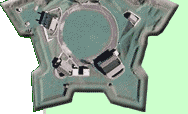
 |
 |
Fort Wood Liberty Island, New York |
 |
 |
 |
 |
||
 |
||||
 |
Just about anybody who's ever thought a nice thought about the United States is most likely familiar with the statue that now tops what was once Fort Wood: The Statue of Liberty! Not long ago I recognized the base of that most famous of statues for what it is: a starfort! Why would the base of such a monument need the defense afforded by the pointiness of a starfort? 'Twas nothing more than financial expedience, as it turns out. What is now known as Liberty Island was previously Bedloe's Island, named for Isaac Bedlow, who bought the island in 1667 from Captain Robert Needham. Needham had been granted the island by English governor Richard Nicolls (1624-1672), shortly after the British had turned the Dutch out of what was then called New Amsterdam, in 1664. The island changed hands several more times over the following decades, on two occasions being commandeered by the city of New York for use as a smallpox quarantine station. The city finally bought Bedloe's Island in 1756 for permanent use as a pest house, a somewhat forced quarantine station. Hopefully all those pests were gone by the time the British used the island to house Tory refugees just before the American Revolutionary War (1775-1783), though surely many Patriots felt Tories to be pests in & of themselves. |
 |
||
 |
|
|||
 |
commanding general at the time, Jacob Brown (1775-1828), thought that this whole first-West-Point-graduate-to-die-in-battle thing was so cool, he had a monument built to Wood at West Point and named the starfort on Bedloe's Island after him as well. In 1865, French sculptor Frederic Bartholdi (1834-1904) was inspired to spearhead a project that would represent the United States' and France's shared concept of independence in, you guessed it, that statue we've already mentioned. Various events intervened before Bartholdi could get serious about the project (he served as a squadron leader in the Franco-Prussian War (1870), for instance), but by 1875 he was ready to get rolling, and a Franco-American Union was formed to raise money for the statue. France would finance the statue, while the US was expected to pay for the pedestal on which it would stand. This all sounds very straightforward and reasonable today, but when it came to actually raising money for the pedestal, America suddenly got incredibly whiny. While money was raised for the statue from across French society with great success, the economy in the US was ailing as a result of the Panic of 1873, when Germany decided to go off the silver standard. This caused an international fall in demand for silver, and as a large proportion of the world's silver was being mined in the US at the time, Americans were feeling somewhat financially diminished. "Why do we have to pay for the whole pedestal while France only has to pay for that dinky little statue?" Knowing what an important part the Statue of Liberty plays in the American psyche today, this all seems pretty ridiculous, but we can rest assured that there are plenty of important things we're whinily arguing about today that folks will be scratching their heads over 130 years from now, too. Fort Wood, meanwhile, hadn't been used for much of anything since 1861, when some 100 Confederate prisoners were held there for a brief period during the US Civil War (1861-1865). "Hey, we could just pour some concrete into that useless thing," came the consensus, while at the same time a campaign to raise money from millions of "little people" across the US, the vast majority of whom donated less than a dollar, was finding success. Fort Wood's garrison was dumped out of their fort, and a new post was built for them just outside its walls. On October 28 1886, the completed Statue of Liberty was finally, officially presented to the world by president Grover Cleveland (1837-1908). Though stationed at what was nothing but a particularly attractively-shaped pedestal, Fort Wood's garrison hung around until 1944, and the garrison buildings were torn down by 1950. Bedloe's Island was officially renamed Liberty Island in 1956. While one has dreamy visions of the Statue of Liberty's starry defenses saving it from hordes of Islamic terrorists, this seems unlikely. Though fun to think about. |
 |
||
 |
||||
|
|
|||||||
Info Source 1
Info Source 2
Info Source 3
Info Source 4
Info Source 5 Info Source 6 Info Source 7 Info Source 8 Info Source 9 Info Source 10 Info Source 11 Info Source 12 Thanks to Google Maps and Wikipedia for the images! ©2011 starforts.com |
 |
 |